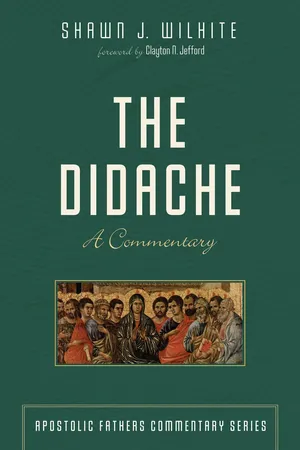
This is a test
- 326 pages
- English
- ePUB (mobile friendly)
- Available on iOS & Android
eBook - ePub
Book details
Book preview
Table of contents
Citations
About This Book
The Apostolic Fathers Commentary Series aims to complement the study of early Christianity through historical, literary, and theological readings of the Apostolic Fathers. Writers of the AFCS volumes seek to be mindful of critical scholarship while commenting on a final-form text. Shawn J. Wilhite's commentary on the Didache includes a brief introduction to the Didache, the use of Scripture by the Didachist, and the theology of the Didache. The commentary proceeds section by section with a close ear to the text of the Didache, relevant early Christian literature, and current scholarship.
Frequently asked questions
At the moment all of our mobile-responsive ePub books are available to download via the app. Most of our PDFs are also available to download and we're working on making the final remaining ones downloadable now. Learn more here.
Both plans give you full access to the library and all of Perlego’s features. The only differences are the price and subscription period: With the annual plan you’ll save around 30% compared to 12 months on the monthly plan.
We are an online textbook subscription service, where you can get access to an entire online library for less than the price of a single book per month. With over 1 million books across 1000+ topics, we’ve got you covered! Learn more here.
Look out for the read-aloud symbol on your next book to see if you can listen to it. The read-aloud tool reads text aloud for you, highlighting the text as it is being read. You can pause it, speed it up and slow it down. Learn more here.
Yes, you can access The Didache by Shawn J. Wilhite, Michael A. G. Haykin in PDF and/or ePUB format, as well as other popular books in Theology & Religion & History of Christianity. We have over one million books available in our catalogue for you to explore.
Information
Topic
Theology & ReligionSubtopic
History of ChristianityPart I
Introductory Articles
1
Introduction to the Didache
When Philotheos Bryennios discovered the Teaching of the Twelve Apostles (Didache) in 1873, it sparked an immediate and lasting interest among early church historians.1 Joan Walker captures the sentiment quite well:
The discovery of the Didache in 1873 has been acclaimed in many a eulogy, in many a language and by many a scholar. And rightly so. For this work has cast a spell over even the most cautious who, finding its magic irresistible, seek time and again to prise its secrets.2
This ancient text (early second century ce) caught the attention of many early Christian scholars shortly thereafter: Adolf Hilgenfeld (1884),3 Adolf von Harnack (1884),4 Paul Sabatier (1885),5 Roswell D. Hitchcock and Francis Brown (1885),6 Philip Schaff (1885),7 and Charles Taylor (1886).8 This ancient writing has generally created problems among Didache scholars—Giet deeming it an “enigma” (1970)9 and Vokes calling the work a “riddle” (1938).10
Bryennios discovered the Didache in 1873 within an eleventh-century codex (Codex Hierosolymitanus [H54]). The Didache was not released to the public until 1883, with the first facsimiles appearing in 1887, because it was overlooked during Bryennios’s initial assessment of H54.11 Upon noticing this neglect, Bryennios exclaimed:
This! This! This! This! This must be the Διδαχη, the book that so many ancient fathers quote, the book that was lost, that the church mourns over to this day, the foundation of part of the Apostolic Constitutions. Εὓρηκα εὓρηκα εὓρηκα.12
In addition to the Didache, the codex contained other works from the Apostolic literature and early Christianity, namely, the Epistle of Barnabas,13 1 and 2 Clement, the longer recension of the Ignatian corpus (13 letters), a Synopsis Veteris et Novi Testamenti of Chrysostom, and a list of Hebrew/Aramaic Hebrew Bible titles with their Greek correspondent titles entitled ὀνόματα τῶν βιβλίων παρ᾽ Ἑβραίοις14—more on this codex below.
The Didache serves as a window into the life of earliest Christianity, the community’s self-identity, and related problems surrounding a nascent (post-) apostolic period.15 Most Didache and early Christian scholars date the Didache to the latter half of the first or the early half of the second century. According to Nancy Pardee, this relatively early date makes the Didache an important witness to the composition and development of the New Testament literature.
Such an early date and stature by themselves would make the Didache an important witness alongside the New Testament of the development of the early Church, but the additional fact that the text is of a more utilitarian nature means that it does not merely supplement the biblical texts, but complements them.16
According to Clayton Jefford, the current landscape of Didache scholarship is reaping the rewards from the labors of previous generations. With the efforts of the initial scholars, several schools of thought emerged in an attempt to reconstruct the context and traditions behind the Didache.17 In the past twenty-or-so years, Didache research has seen a resurgence of both collaborative efforts and specialized monographs. Particularly notable in this regard was an exploratory series of paper presentations, “Didache Consultation Unit,” at the Society of Biblical Literature (SBL) from 2003–2005 and “Didache in Context” from 2005–2011 under the direction of Aaron Milavec, Jonathan Draper, Nancy Pardee, Clayton Jefford, Huub van de Sandt, and Alan Garrow. This nearly decade focus eventually produced the recent 20...
Table of contents
- Title Page
- Series Preface
- Foreword
- Preface
- Abbreviations
- Tables
- Translation of Didache
- Part I: Introductory Articles
- Commentary on the Didache
- Bibliography